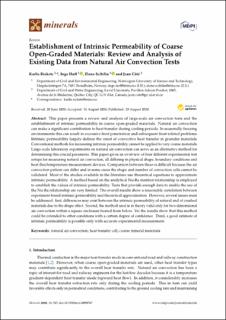| dc.contributor.author | Rieksts, Karlis | |
| dc.contributor.author | Hoff, Inge | |
| dc.contributor.author | Scibilia, Elena | |
| dc.contributor.author | Côté, Jean | |
| dc.date.accessioned | 2020-09-08T06:08:15Z | |
| dc.date.available | 2020-09-08T06:08:15Z | |
| dc.date.created | 2020-08-31T11:14:09Z | |
| dc.date.issued | 2020 | |
| dc.identifier.citation | Minerals. 2020, 10 (9), . | en_US |
| dc.identifier.issn | 2075-163X | |
| dc.identifier.uri | https://hdl.handle.net/11250/2676745 | |
| dc.description.abstract | This paper presents a review and analysis of large-scale air convection tests and the establishment of intrinsic permeability in coarse open-graded materials. Natural air convection can make a significant contribution to heat transfer during cooling periods. In seasonally freezing environments this can result in excessive frost penetration and subsequent frost-related problems. Intrinsic permeability largely defines the onset of convective heat transfer in granular materials. Conventional methods for measuring intrinsic permeability cannot be applied to very coarse materials. Large-scale laboratory experiments on natural air convection can serve as an alternative method for determining this crucial parameter. This paper gives an overview of four different experimental test setups for measuring natural air convection, all differing in physical shape, boundary conditions and heat flux/temperature measurement devices. Comparison between these is difficult because the air convection pattern can differ and in some cases the shape and number of convection cells cannot be validated. Most of the studies available in the literature use theoretical equations to approximate intrinsic permeability. A method based on the analytical Nu-Ra number relationship is employed to establish the values of intrinsic permeability. Tests that provide enough data to enable the use of the Nu-Ra relationship are very limited. The overall results show a reasonable correlation between experiment-based intrinsic permeability and theoretical approximation. However, several issues must be addressed: first, differences may exist between the intrinsic permeability of natural and of crushed materials due to the shape effect. Second, the method used is in theory valid only for two-dimensional air convection within a square enclosure heated from below. Yet the results show that this method could be extended to other conditions with a certain degree of confidence. Third, a good estimate of intrinsic permeability is possible only with accurate experimental measurement. | en_US |
| dc.language.iso | eng | en_US |
| dc.publisher | MDPI | en_US |
| dc.rights | Navngivelse 4.0 Internasjonal | * |
| dc.rights.uri | http://creativecommons.org/licenses/by/4.0/deed.no | * |
| dc.title | Establishment of Intrinsic Permeability of Coarse Open-Graded Materials: Review and Analysis of Existing Data from Natural Air Convection Tests | en_US |
| dc.type | Peer reviewed | en_US |
| dc.type | Journal article | en_US |
| dc.description.version | publishedVersion | en_US |
| dc.source.pagenumber | 22 | en_US |
| dc.source.volume | 10 | en_US |
| dc.source.journal | Minerals | en_US |
| dc.source.issue | 9 | en_US |
| dc.identifier.doi | 10.3390/min10090767 | |
| dc.identifier.cristin | 1826179 | |
| dc.description.localcode | © 2020 by the authors. Licensee MDPI, Basel, Switzerland. This article is an open access article distributed under the terms and conditions of the Creative Commons Attribution (CC BY) license (http://creativecommons.org/licenses/by/4.0/). | en_US |
| cristin.ispublished | true | |
| cristin.fulltext | original | |
| cristin.qualitycode | 1 | |

